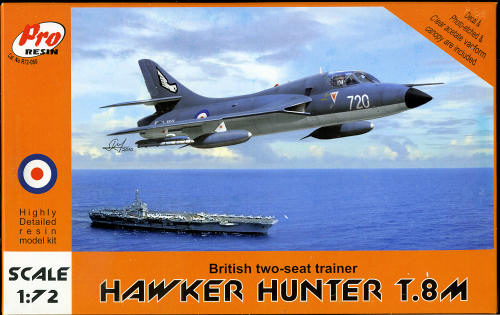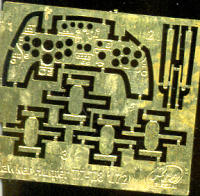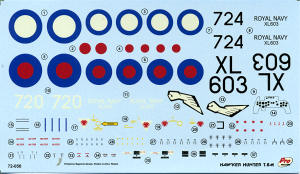
Pro Resin 1/72 Hawker Hunter T.8M
| KIT #: | R72-050 |
| PRICE: | $60.00 SRP |
| DECALS: | Two options |
| REVIEWER: | Scott Van Aken |
| NOTES: | Resin with etched parts and vacuformed canopy |

| HISTORY |
The Hawker Hunter was a British jet fighter aircraft of the 1950s and 1960s. The Hunter served for many years with the Royal Air Force and was widely exported, serving with 19 air forces. A total of 1,972 Hunters were produced by Hawker Siddeley and under license.
Two-seat trainer versions of the Hunter, theT 7 and T 8 remained in use for training and secondary roles by the RAF and Royal Navy until the early 1990s.
The Hunter was exported to over 20 countries, each nation accepting at least one two seat aircraft for conversion training.
The Hunter T.8 XL 603 was one of the last trainer Hunters built, rolling off the assembly line in December of 1958 and turned over to the Royal Navy at Lossiemouth the next month. In 1975 it was converted to T.8M specs with the installation of the Sea Harrier's Blue Fox radar for trials. Following its successful trials time it was then transferred to the Sea Harrier training unit, 899 Squadron in early 1983 and used to help train Sea Harrier FRS.1 pilots. It went through several different nose codes and in 1990 was overhauled, during which time it gained its overall dark sea grey color scheme and low visibility roundels. In late 1993 the aircraft made its final flight and was sold in 1994. After changing hands, it was shipped to the US. As of 2000 nothing is known of the fate of this aircraft as it was allegedly going to be restored to flying condition.
| THE KIT |
 Pro Resin's kit is molded in the usual tan shade that we have come to expect from most resin kits. You notice right away that there are a lot of parts in the bag and this can cause some parts to dislodge from their pour stubs.
Pro Resin's kit is molded in the usual tan shade that we have come to expect from most resin kits. You notice right away that there are a lot of parts in the bag and this can cause some parts to dislodge from their pour stubs.
Detailing is superb. Molding is very nicely done with minimal voids. The kit's nose section and wheel wells have nicely molded in detailing. The fuselage is in four sections, which is OK, but I'm sure most would have preferred it to be just two pieces to eliminate the additional seam. However, it does offer the possibility of doing other Hunter variations. The kit has a separate nose section as often that is the major difference between variants. Two drop tanks are provided for the inner stations and there are also outer pylons in case you wish to add something there.
The nicely done one piece wings have separate flaps and the intake is molded in one section as well, making for no worries on inside seams. The pylon attachment holes are pre-drilled in the bottom of the wings so if you want to leave any off, you'll need to fill the holes. The cockpit comes with separate rudder pedals and control sticks. The seats are well molded, look to be the proper  type and have harness detail molded in place. Photo etch is used minimally consisting of the rudder pedals, instrument panel and dual windscreen wipers for the vacuformed canopy. Thankfully, two of these are supplied in case you goof on one or want to have the canopy open. I should also point out that there is room in the nose section for weight if you feel it needs it. The instructions don't list any, but I'm always gun-shy when it comes to resin and will put weight in there just in case. The kit is also supplied with nicely done landing gear, doors and wheels. The speed brake can be shown raised or lowered. I should also note that the tail section has the parabrake housing molded in place, which I believe is the norm for all two seat Hunters.
type and have harness detail molded in place. Photo etch is used minimally consisting of the rudder pedals, instrument panel and dual windscreen wipers for the vacuformed canopy. Thankfully, two of these are supplied in case you goof on one or want to have the canopy open. I should also point out that there is room in the nose section for weight if you feel it needs it. The instructions don't list any, but I'm always gun-shy when it comes to resin and will put weight in there just in case. The kit is also supplied with nicely done landing gear, doors and wheels. The speed brake can be shown raised or lowered. I should also note that the tail section has the parabrake housing molded in place, which I believe is the norm for all two seat Hunters.
This kit differs from the previous boxing by having a different nose section as well as a tail hook, and missile shapes for the outer pylons. I'm thinking these were used more as spoof transmitters than actual missile representations.
 Instructions have eight nicely drawn construction steps that include color information. This is provided with generic, Humbrol, Model Master and Revell color references. There are markings for the two camo schemes carried by XL 603. The initial is extra dark sea grey over white. This grey color weathered rather badly. The other is in a near gloss dark sea grey and was carried for the last years of its life. There are plenty of photos of this plane on the net if you choose to google for it. The decals are very nicely printed by Begemont and provide a full stencil suite with the instructions having an excellent stencil placement guide. By the way, there were three T.8Ms built. Those who want to model the other two will need to find different serials and nose codes to properly duplicate them. Modeldecal does, or did, several sheets of numbers and letters in the proper font.
Instructions have eight nicely drawn construction steps that include color information. This is provided with generic, Humbrol, Model Master and Revell color references. There are markings for the two camo schemes carried by XL 603. The initial is extra dark sea grey over white. This grey color weathered rather badly. The other is in a near gloss dark sea grey and was carried for the last years of its life. There are plenty of photos of this plane on the net if you choose to google for it. The decals are very nicely printed by Begemont and provide a full stencil suite with the instructions having an excellent stencil placement guide. By the way, there were three T.8Ms built. Those who want to model the other two will need to find different serials and nose codes to properly duplicate them. Modeldecal does, or did, several sheets of numbers and letters in the proper font.
| CONCLUSIONS |
A very nice resin kit that will surely appeal to many. There have been conversions in both vacuformed plastic and resin available over the years, but now we have a complete kit with some excellent markings choices.
| REFERENCES |
Kit instructions March 2011 Thanks to Pro Resin for the preview kit. Visit their website for a list of retailers. If you would like your product reviewed fairly and fairly quickly, please contact the editor or see other details in the Note to Contributors.